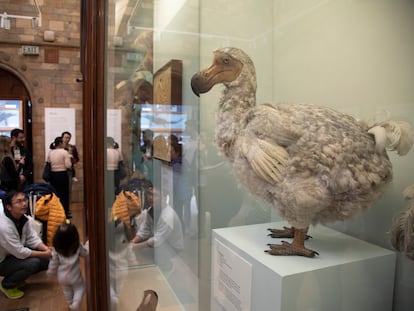Study identifies the 14 dead ends threatening humanity
Researchers have mapped the evolutionary traps facing society, from chemical pollution to misaligned technology, and proposed ways to avoid them

If an insect is attracted to an artificial light and dies upon approaching it, the animal has been the victim of an evolutionary trap. These traps are used to study how non-human species respond to signals from the human environment. If, instead of an insect, it is humanity that falls into one of these traps, society could find itself stuck in one of the 14 evolutionary dead ends identified by a group of researchers from Stockholm University. This list includes short-termism, overconsumption, biosphere disconnect and lack of social cohesion, as the authors reveal in their study, published by the Royal Society.
The Anthropocene — the proposed geological stage in which humans are the main driver of change on the planet — is showing more and more cracks. This period is characterized by quickening change and increasingly complex global challenges, such as the Covid-19 pandemic, climate change, food insecurity, financial crises and conflicts. Could the Anthropocene itself be an evolutionary trap?
The new study compares the current situation with what the Earth experienced billions of years ago during the so-called Great Oxidation Event. During this period, the evolutionary success of cyanobacteria — the first organisms that produced oxygen as a result of photosynthesis — greatly enriched the atmosphere with the gas; and this caused the mass extinction of most living beings, for whom oxygen was toxic. The big difference is that now the species responsible for the big changes are aware of them and can do something to preserve biodiversity. That’s why, the new study also explores solutions, so that society continues its evolution along a more sustainable path.
One of the most advanced traps, explains Peter Søgaard Jørgensen, the lead author of the study, “is the short-termism that leads to focusing on rapid economic growth, instead of long-term economic sustainability.” “The highly interconnected world we live in means that we often do not see the consequences of our own behaviors, which remain masked,” adds Søgaard, who is a researcher at the Stockholm Resilience Center.
In their research, Søgaard’s team developed a method to identify a dead end. In order to qualify, it had to be described as evolving from an initially adaptive process; show signs of negatively impacting human well-being on a global level or be expected to do so in the future, and have a trapping mechanism that makes escaping the negative impacts more difficult when triggered.
The 14 evolutionary traps identified in the study are the simplification of food production ecosystems, growth at the expense of social well-being, the overshoot of the Earth system tipping points, the division of humanity by conflicts, large-scale contagion, fossil fuel infrastructure lock-in, chemical pollution, existential technology, technological autonomy, misinformation, short-termism, overconsumption, biosphere disconnect and local social capital loss.
Some of the consequences of evolutionary traps cannot be seen directly, but rather negatively impact the global system, such as the degradation of services and technological failures. For example, antibiotic resistance kills 1.2 million people a year, more than AIDS or malaria, but “these failures are masked for most people in their daily lives,” says Søgaard. In view of this problem, Victoria Lladó, director of Corporate Strategy at Laminar Pharma, argues that the population needs to commit to taking antibiotics only under medical prescription and to properly dispose of surpluses. The key, says Lladó, is “awareness, awareness and awareness.”
Technological threats
Technological traps are the result of general dynamics, according to the study. Innovation has led to dependence on fossil fuels and the health impacts of new synthetic components and materials produced by technology. Despite being one of the traps in a less advanced state, along with the loss of social capital, technological autonomy is rising amid growing investment in new forms of artificial intelligence (AI) and robotics, such as self-driving cars.
The different dead ends overlap and reinforce each other. For example, the severity of overconsumption can be measured through polluting activities and the loss of ecosystems and biodiversity. One of the species that are being lost due to climate change are corals, according to Moisés Expósito-Alonso, a biologist and scientist at Stanford University. High ocean temperatures cause reef bleaching and corals to starve. In April, the U.S. National Oceanic and Atmospheric Administration revealed that the average ocean temperature broke a record at 21.1°C. “For the same reason, polar bears are losing their habitat, and plants like the Sequoia do not have the necessary humidity to live,” explains Expósito-Alonso.
Francisco Lloret, a professor of ecology at the Autonomous University of Barcelona, recommends implementing measures “that favor resilient natural processes, such as the construction of corridors between territories that ensure the maintenance of biodiversity and allow the arrival of new individuals to weakened populations.” He also suggests restoring or renaturalizing habitats that have been destroyed.
Avoid polarization
Søgaard believes it’s possible to avoid dead ends if certain measures are adopted: understanding the evolutionary traps, better identifying them, changing paths to avoid their harmful consequences, reorganizing society and creating new institutions and technologies that can be dismantled and restructured when necessary.
The local social capital loss and political polarization contribute to misinformation. This leads to global division, as national tensions hinder the international community from reaching commitments. For Søgaard, the most important thing is “being able to reconcile conflicts and reach across the aisle with those with whom we would otherwise be less likely to cooperate.”
Another way to resolve these situations is to act collectively on a large scale. “It’s time for humans to become aware of the new reality and to collectively move where we want to as a species. We have the capability to do that and are already seeing signs of such movements. We can break out of dead ends,” concludes Søgaard.
Sign up for our weekly newsletter to get more English-language news coverage from EL PAÍS USA Edition
Tu suscripción se está usando en otro dispositivo
¿Quieres añadir otro usuario a tu suscripción?
Si continúas leyendo en este dispositivo, no se podrá leer en el otro.
FlechaTu suscripción se está usando en otro dispositivo y solo puedes acceder a EL PAÍS desde un dispositivo a la vez.
Si quieres compartir tu cuenta, cambia tu suscripción a la modalidad Premium, así podrás añadir otro usuario. Cada uno accederá con su propia cuenta de email, lo que os permitirá personalizar vuestra experiencia en EL PAÍS.
¿Tienes una suscripción de empresa? Accede aquí para contratar más cuentas.
En el caso de no saber quién está usando tu cuenta, te recomendamos cambiar tu contraseña aquí.
Si decides continuar compartiendo tu cuenta, este mensaje se mostrará en tu dispositivo y en el de la otra persona que está usando tu cuenta de forma indefinida, afectando a tu experiencia de lectura. Puedes consultar aquí los términos y condiciones de la suscripción digital.











































